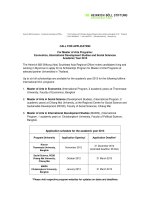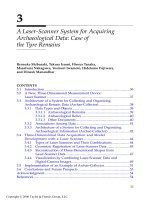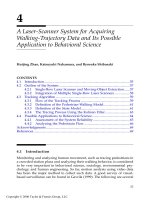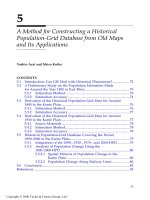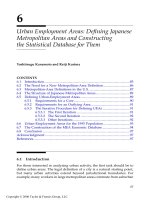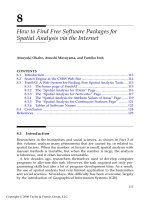The Influence of Gender and Ethnicity on the Use of ICT in Higher Education A Case of Arts and Social Sciences Students in Universiti Malaya
Bạn đang xem bản rút gọn của tài liệu. Xem và tải ngay bản đầy đủ của tài liệu tại đây (406.82 KB, 125 trang )
The Influence of Gender and Ethnicity on the use of ICT in Higher Education
A Case of Arts and Social Sciences Students in Universiti Malaya
A thesis presented to
the faculty of
the Center for International Studies of Ohio University
In partial fulfillment
of the requirements for the degree
Master of Arts
Animesh S. Rathore
November 2008
© 2008 Animesh S. Rathore. All Rights Reserved.
2
This thesis titled
The Influence of Gender and Ethnicity on the use of ICT in Higher Education
A Case of Arts and Social Sciences Students in Universiti Malaya
by
ANIMESH S. RATHORE
has been approved for
the Center for International Studies by
Drew O. McDaniel
Professor, School of Media Arts & Studies
Gene Ammarell
Director, Southeast Asian Studies
Daniel Weiner
Executive Director, Center for International Studies
3
ABSTRACT
RATHORE, ANIMESH S., M.A., November 2008, Southeast Asian Studies
The Influence of Gender and Ethnicity on the use of ICT in Higher Education
A Case of Arts and Social Sciences Students in Universiti Malaya
(125 pp.)
Director of Thesis: Drew O. McDaniel
While most studies on ICT use among students have typically focused on students
in the field of science and technology, this study focuses on a group that has seldom been
studied for its ICT use—students in Arts and Social Sciences. Based on a survey of 32
students conducted at the Faculty of Arts and Social Sciences at Universiti Malaya during
December 2006, this study examines the relationships among gender, ethnicity, and
students’ ICT use. The findings of this study suggest that the female students spent
significantly more time using ICT for study purposes than males. The interviews with
faculty members revealed that female students spent more time on studies and were less
likely to cheat or plagiarize. However, the study found no such difference between
Bumiputra and non-Bumiputra students.
Approved: _____________________________________________________________
Drew O. McDaniel
Professor, School of Media Arts & Studies
4
ACKNOWLEDGMENTS
I still remember the summer of 1991, when my mother took a major decision to
go back to school after a gap of 25 years. Her determination was so strong that despite
some resistance from my brothers and relatives, she pursued her degree in education and
started working as a primary school teacher at the same school in India where my father
had served as a principal for eight years before his demise in January 1991. If it was not
for the hard work my mother had put in raising my sister and myself, I would certainly
not be able to pursue the academic career I have now. My mother’s sacrifices and
determination to keep standing in a conventionally patriarchal society has always
motivated me to study gender development across the developing world. I owe almost
everything I have today to her dedication and perseverance.
I sincerely wish to thank all those who extended help and support in different
ways and made it possible for me to complete this thesis. I am grateful to the Center for
International Studies at Ohio University for allowing me to pursue my research interest in
Malaysia and awarding me the prestigious Southeast Asian Studies Research Travel
Grant that enabled me to travel to Malaysia for my fieldwork. I am thankful to the
International Institute of Public Policy and Management (INPUMA) at Universiti Malaya
for accepting me as a visiting scholar and providing the necessary support during the data
collection. I am also thankful to the Institutional Review Board at Ohio University for
being so prompt in approving my research plan and subsequent revisions.
Personally, I wish to thank Dr. Sharifah M. Alhabshi (Deputy Director,
INPUMA), Mr. Hirman Awang (Asst. Registrar, INPUMA), Ms. Vigneshree King (Asst.
5
Registrar, Faculty of Arts and Social Sciences) and other administrative staff at Universiti
Malaya. Among the faculty members, I would like to thank Dr. Joseph M. Fernando
(History), Dr. Shanthi Thambiah (Gender Studies), Dr. Carol E. Leon (English), Dr. Lim
Chee Seng (English), and Mr. Thirunaukarasu Subramaniam (South East Asian Studies)
for sharing their valuable insights with me.
At Ohio University, I would like to thank Prof. Mohamad Abu Bakar (the 2005-
07 Tun Abdul Razak Chair from Department of International and Strategic Studies,
Universiti Malaya), Dr. Gene Ammarell (Director, Southeast Asian Studies), Dr. Liren
Zheng (Curator and Bibliographer, Chinese Studies, Cornell University Library), and
especially Dr. Haley Duschinski (Sociology and Anthropology) for their useful inputs
and encouragement at different times. I am thankful to Ms. Karla Schneider and the other
staff at the Center for International Studies for always being so supportive. I am also
thankful to my family and all my friends and colleagues at Ohio who helped me at
several occasions in different ways.
Finally, I would like to express my sincere gratitude towards my advisor Dr.
Drew McDaniel (Media Arts and Studies) for being an immense source of inspiration,
valuable guidance, constructive criticism, as well as unconditional support at the right
times during the course of this thesis.
6
TABLE OF CONTENTS
Page
Abstract 3
Acknowledgments 4
List of Tables 9
List of Figures 10
Chapter 1: Introduction 11
Aim 21
Research Questions 21
Chapter 2: Review of Literature 23
ICT, Gender, and Ethnicity in Higher Education 23
ICT, Gender, Ethnicity, and Higher Education in Malaysia 32
Summary 41
Chapter 3: Malaysia: A Background 43
Demography 43
Ethnic Groups in Malaysia 43
The Malays 44
The Chinese 45
The Indians 48
Ethnic Integration and Politics in Malaysia 51
The New Economic Policy 55
Malaysia’s Technological Growth 60
7
Gender and Development in Malaysian Context 63
Women in Colonial Economy 64
Gender across Ethnic Groups 66
Women and Politics 66
Women in the New Economy 68
Gender Development in Malaysia: Key Challenges 70
Summary 71
Chapter 4: Research Methodology 73
Method 74
Proxies 74
Survey Tool 75
Sampling 79
About Universiti Malaya 81
About the Faculty of Arts and Social Sciences 82
PTM: Centre for IT 83
Analysis 83
Summary 84
Chapter 5: Research Findings 85
Testing the Hypotheses 85
Other Findings 91
Chapter 6: Discussion And Conclusions 99
Discussion 99
8
Conclusion 107
Limitations & Recommendations 110
References 111
Appendix A: Questionnaire 122
9
LIST OF TABLES
Page
Table 1: Mean of total weekly hours spent on computer (including Internet) for
studies by ethnicity 86
Table 2: Mean of total weekly hours spent on computer (including Internet) for
studies by gender 86
Table 3: Mean of total weekly hours spent on studies by gender 86
Table 4: Mean of total weekly hours spent on studies by ethnicity 88
Table 5: Computer access at home across Bumiputra and non-Bumiputra students 88
Table 6: Computer access at home across female and male students 88
Table 7: Self-reported level of computer use across Bumiputra and non-
Bumiputra students 90
Table 8: Self-reported level of Computer Use across female and male students 90
Table 9: Willingness to spend on ICT across Bumiputra and non-Bumiputra
students 92
Table 10: Willingness to spend on ICT across female and male students 92
Table 11: Difficulty in computer access across Bumiputra and non-Bumiputra
students 92
Table 12: Difficulty in computer access across female and male students 93
Table 13: Difficulty in using computer across Bumiputra and non-Bumiputra
students 93
Table 14: Difficulty in using computer across female and male students 94
10
LIST OF FIGURES
Page
Figure 1: The MSC Malaysia Vision 62
Figure 2: Opinion on computer being helpful in studies (by ethnicity) 95
Figure 3: Opinion on computer being helpful in studies (by gender) 95
Figure 4: Opinion on computer often being a cause of frustration (by ethnicity) 96
Figure 5: Opinion on computer often being a cause of frustration (by gender) 96
Figure 6: Opinion on Internet often being a cause of frustration (by ethnicity) 97
Figure 7: Opinion on Internet often being a cause of frustration (by gender) 97
Figure 8: Opinion on Internet being helpful in academic work (by ethnicity) 98
11
CHAPTER 1: INTRODUCTION
In the summer of 2002, after finishing my graduate program in Development
Communication, I received a unique opportunity to work on a study titled ‘Engendering
ICT’ (Information and Communication Technology) as a research associate at the Indian
Institute of Management, Ahmedabad. This was my first experience of researching socio-
cultural issues from a gender perspective, which was both challenging as well as
interesting for me. I learned about the immense potential of ICTs and even simple
technologies in improving the status of women in society. The global nature of the
project made me aware of the importance of socio-cultural factors influencing the use of
ICTs by women across different regions.
Later, between November 2003 and August 2005, I became involved in web-
publishing an online newsletter titled ‘Information Technology in Developing Countries’.
It was during this time that I learned about the tremendous ICT development across the
Southeast Asian region, especially Malaysia. I found that the dispersion of technology
has been highly uneven around the world. While many people in the developed world
appeared to take the availability of computer and the Internet for granted as they had easy
access, the people in a number of developing countries who considered these
technologies as substantial means for their socio-economic advancement had limited ICT
access. However, some of the post-colonial developing countries, like Malaysia, had been
able to demonstrate a substantial socio-economic growth as well as had the ability to
benefit from the advent of IT (Information Technology). During my graduate studies at
Ohio University in 2005-06, I became further interested in Malaysia due to a variety of
12
reasons, including (but definitely not limited to) its rich wildlife and natural resources,
rapid economic and technological growth, and most importantly its cultural diversity.
It was my understanding that for any country or government, education was one
of the primary means of socio-economic development, especially for the economically
disadvantaged or marginalized groups. Based on my understanding and personal
experiences, I became curious about how the education system in Malaysia had
responded to the technological advancements during the past two decades and how it
related to the overall gender and ethnic development in the country. For me, one way of
assessing this was to explore the extent to which the college students with different
gender and ethnic backgrounds used computer and Internet in their academic work?
Through this research study, I intended to seek an answer to my question.
The introduction and propagation of ICTs had clearly been receiving a lot of
attention across various fields the world over. The field of education, too, had been trying
to benefit from the potential of the new technology in different parts of the world.
However, for some, there was a little evidence of ICT being deployed in the field of
education as extensively as it had been in some other fields, such as banking. Oliver
noted:
If one was to compare such fields as medicine, tourism, travel, business, law,
banking, engineering and architecture, the impact of ICT across the past two or
three decades has been enormous. The way these fields operate today is vastly
different from the ways they operated in the past. But when one looks at
13
education, there seems to have been an uncanny lack of influence and far less
change than other fields have experienced (Oliver, 2002, p. 1).
Thus, I got further interested in knowing what was happening in a country like
Malaysia where education is indeed an important part of the overall IT strategy. I became
interested in seeing how female students were making use of the technology (wherever
available) for their educational advancement. I also found that while most studies on the
use of ICTs so far had primarily focused either on the students in pure sciences or in the
fields that typically involved the use of ICTs, such as IT Management, there was almost
no accessible literature that focused on Arts and Social Sciences students. Thus, in this
study, I planned to focus on the discipline of Arts and Social Sciences (an otherwise less
studied group) for its use of ICT.
As mentioned earlier, I had been most interested in the cultural diversity aspect of
Malaysia, something that was quite visible in my home country India as well. The
Malaysian population could be broadly divided into two major groups, namely,
Bumiputra (Malay word for “son of the earth”) and non-Bumiputra. The Bumiputra
included Malays and indigenous peoples from the Peninsula, Sabah, and Sarawak. The
non-Bumiputra included ethnic Chinese, Indians (primarily of Tamil origin), and other
groups, such as Ceylonese Tamils (from Sri Lanka). Among the non-Bumiputra, who
formed roughly around 35 percent of Malaysia’s total population in 2004, the Chinese
were the largest ethnic group, as they formed almost 24 percent of the country’s
population at the time (Jabatan Perangkaan Malaysia, 2004a, p. 37). Pan (2006) reported
that Southeast Asia had the highest number of overseas Chinese immigrants in the world
14
and within Southeast Asia, Malaysia had the largest number of ethnic Chinese (over four
million). By 2004, the number of ethnic Chinese had crossed the six million mark
(Jabatan Perangkaan Malaysia, 2004a, p. 37). The Chinese were mostly based in urban-
centers, especially Kuala Lumpur, and had been involved in various economic activities
(Pan, 2006).
With a population of over 1.8 million or seven percent of Malaysia’s total
population in 2004, the Indians formed the second largest non-Bumiputera ethnic group
in the country (Jabatan Perangkaan Malaysia, 2004a, p. 37). Most of the ethnic Indians
were brought to Malaya primarily as rubber-plantation workers and as civil-servants by
the British during the colonial rule, many of whom remained in majority numbers near
the former plantations areas (also known as the rubber-zones) and also as minorities at
urban centers like Kuala Lumpur, and Melaka—an old port city in current day Malaysia
famous for its significant trade and strategic location from the earlier times (Arasaratnam,
1979 & Sandhu, 1993). Although an early migration of these groups was evident, the
presence of the Chinese and the Indians in large numbers in recent times was mainly a
result of British colonization of Malaya and the Straits Settlements (early territories of the
British East India Company in the Southeast Asian region including Penang, Melaka,
modern day Singapore, and the islands of Dinding and Province Wellesley)
and the
increased demands for labor on rubber plantations as well as tin mines during the colonial
era (between the nineteenth and mid-twentieth centuries). Also, there were “push” factors
within China and “pull” factors within Malaya that encouraged many Chinese men to
migrate (Suryadinata, 1997, p. 9).
15
Interestingly, the role of Chinese in the Malayan economy during the British
colonial period was much more varied and widespread than either of the native Malays or
Indians, who were primarily involved in agriculture, rubber plantation, and
administration to some extent. The Chinese were involved in a host of activities ranging
from tin mining, transportation, food processing, rubber production, and urban jobs (Pan,
2006). The unequal demographic composition of Malaya and the strategic importance of
Chinese, who had sound knowledge of local markets and labor, enabled the Chinese to
act as a strong socio-political force as well. The economic opportunities in the new Straits
Settlements, thus, enabled the Chinese to take the top spot in the social structure under
the British, while the Malays and the Indians followed.
Even after thirteen years of independence from the British, the Malaysian
economy in 1970 was still dominated by the British companies and expatriates (63.3
percent) followed by the Chinese (27.2 percent), with a meager 2.4 percent as the Malay
share (Pan, 1998). Although the British still dominated the economy, the opportunities
for the Chinese to prosper in the new economy were ample. According to Munro-Kua:
At independence, in 1957, Malaya stood second only to Japan in terms of
economic development although it can be argued that it had the resources
capability to be ahead of the other Non Industrialized Countries (Munro-Kua,
1996, p. 1).
The Chinese were ideally placed to benefit from this situation. This continued domination
of Malaysian economy by the Chinese intensified the tension across the Chinese and the
native (Malay) population and contributed substantially towards the mass rioting against
16
the Chinese on May 13, 1969 (Sandhu, 1993; and Pan, 1998). Following the 1969 riots,
the Malaysian government deployed the New Economic Policy (NEP) to end poverty and
to strike some balance across different ethnic groups. Munro-Kua further noted:
The New Economic Policy was introduced through the Second Malaysian Plan
(1971-76) as a strategy to increase Malay participation in the economy. UMNO
(the dominant political party in Malaysia) claimed this was to resolve the alleged
root cause of the 1969 riots, seen as being derived from too much accommodation
to non-Malays which had in turn fostered resentment among the Malays (Munro-
Kua, 1996, p. 62).
The steps undertaken within this policy primarily focused on improving the status
of Bumiputra and included steps such as expansion of Bumiputra share ownership and
employment in various sectors of the economy including various forms of trade (Pan,
1998). Although the Bumiputra included Malays and other indigenous groups, such as the
Kadazans, the government reportedly seemed to be biased towards the Malays more than
others. In any case, these efforts seemed to have little impact on the problems of lower-
income Malay peasants as well as other indigenous groups in rural areas (Fenton, 1999,
p. 148). Moreover:
the granting of special privileges to Malays has been opposed in the past by non-
Malays such as Chinese and Indians. However, since the May 13th incident, the
government has made it illegal for people to raise these issues as they are
considered to be sensitive (Othman, 1983, p. 47).
17
While the disparities existent in the market at the time of 1969 riots eventually started
reducing and the Malay share increased almost ten-fold from 2.4 to over 20 percent by
the 1990s, it could not surpass the then increasing Chinese share (of almost 45 percent)
(Pan, 1998). The government claimed that those improvements were a result of the NEP,
but several authors, including Jomo (1994 & 2003), had argued that the pro-Bumiputra
aspect of the NEP had little to do with the phenomenal economic and technological
developments in Malaysia during the past decades.
Over a period of time, especially during Mahathir Mohamad’s leadership, the pro-
Bumiputra aspect was not emphasized as much as Malaysia’s overall socio-economic
progress within the NEP (Jomo, 1994). In 1991, Mahathir delivered his famous speech
“Malaysia: The Way Forward” and declared “Vision 2020”—a strategy to attain the
status of a developed country by the year 2020 (Jomo, 1994, p. 51). One of the key
objectives of this vision was to make Malaysia “a scientific, progressive, innovative and
forward-looking society” by the year 2020 (Jomo, 1994, p. 52). Keeping in line with this
progressive agenda and to enhance country’s potential to gain from the IT boom
Malaysia launched a large-scale IT plan during the mid-1990s. The project started with
the establishment of the Multimedia Super Corridor (MSC), which included a physical
location as well as a set of policies aimed at making Malaysia a “knowledge-based
economy” through the means of ICTs by 2020 (McDaniel, 2002, p. 94).
One of the seven key MSC policies had been to promote the use of ICTs in
education at various levels. For instance, at the institutions of primary education, an effort
called “Smart School” had been initiated (MSC, 2007). Similarly, it was apparent that the
18
institutes of higher (especially technical) education had also been receiving growing
attention, and ICTs were becoming an integral part of the higher education system in
Malaysia. However, for some researchers, such as Kamogawa (2003), there was a need to
re-conceptualize the MSC initiative in order to increase female participation in technical
education in Malaysia during the recent times. There was clearly some disparity between
Kamogawa’s argument and Yong & Ng’s (1999) account in which the percentage of
women in IT education programs was fairly high in the early 1990s. In fact, “women
comprised 51.4 percent of total enrollment in the IT field in the seven local universities
for the 1990-1 academic year” (Yong & Ng, 1999, p. 146). This raised a question of
whether or not the implementation of MSC was providing a favorable environment in
terms of increasing or even maintaining the number of female students in IT fields,
although IT was only one of the many areas within the field of technical education.
Just like the economic development or the dispersion of technology, the gender
development also appeared to be highly uneven across different parts of the world.
Although there had been various examples of prominent woman leaders across the
developing world, the overall socio-cultural status of women across most developing
societies continued to be secondary to men due to their (societies’) patriarchal roots.
Things had changed, and were continuously changing, from a gender perspective from
time to time and with different stages of development in a society, but these changes
often appeared to be slow, made a weak impact in the rural regions, and were usually not
radical. For instance, according to UNESCO:
19
…despite major overall expansion in student enrolments in recent years, access
and participation, especially for women, non-urban populations and members of
minority groups remain a problem in the region (Asia) (UNESCO, 2003, p.19).
It, thus, seemed quite possible that the disparity reported by Kamogawa might
perhaps be visible in an ethnic context, too. As Mohamad noted, Malays understood the
value of education through the teachings of Quran, but were worried about the “education
provided in schools and institutions of higher learning inculcate new values which are not
suitable for the Malays” (1987, p. 18). This resistance, according to Mohamad,
contributed towards the poor performance of Malays in technical courses as well as in the
job market. Mohamad (1987) also reported that the conventional Islamic education
system did not provide much scope for potential scientists or mathematicians. However,
during the past few decades, the government had made substantial efforts towards
overcoming this issue. For instance, the higher education (technical courses in particular)
for the Bumiputra had been subsidized as a result of a pro-Bumiputra policy structure.
Moreover, they could also apply for funding for overseas education (Hassan, 2001, p.
13).
As far as more recent studies on ethnicity in Malaysia were concerned, Zainab
Nordin had conducted a study in 1997 on the attitude of government employees across all
the ministries in Malaysia towards the MSC effort (McDaniel, 2002). Besides many other
interesting findings, the study results indicated that there were “striking differences
among Malaysian ethnic groups in their technical capabilities” (cited in McDaniel, 2002,
p. 98). That is, only about 18 percent of Malays and 22 percent of the Indians were
20
experts or were very familiar with computers in terms of their skills, as opposed to 46
percent of the Chinese employees (cited in McDaniel, 2002, p. 98). However, in light of
the pro-Bumiputra policy environment discussed earlier (Munro-Kua, 1996 and Hassan
2001), it could be argued that this trend might not be similar across the university level
Arts and Social Sciences students in the year 2006. Likewise, I would argue that
Kamogawa’s (2003) study that focused on technical education and showed low female
participation was perhaps only reflective of the fact that the participation of female
students in technical education was low, and not that the female students overall were not
making use of the available technology in their education (especially in the field of Arts
and Social Sciences).
A study carried in Israel by Soker (2005) focused on ICT, gender as well as
ethnicity. The survey looked at ICT use in an Open University environment over a period
of seven years and found a significant gap between male and female users. However,
there had been no such studies conducted in Malaysia that focused on ethnicity, gender,
higher education, as well as ICT, while focusing on Arts and Social Sciences’ students.
In sum, Malaysia appeared to be a fascinating ground to explore the relationship
between ethnicity and ICT use in higher education. Also, the issue of gender equality
across different ethnic groups in Malaysia offered sufficient scope for a detailed inquiry,
and I was really interested in studying how female students from diverse cultural
backgrounds would perceive the ICTs and their potential in their educational as well as
long-term advancement. As the MSC had been implemented for over a decade, I felt it
was an apt time to start assessing the social outcomes on the ground. I chose to go to
21
Univerisiti Malaya at Kuala Lumpur during the month of December 2006 to conduct the
fieldwork for this study. Univerisiti Malaya was a national university with over 30,000
students at undergraduate and graduate levels, spread across different disciplines. Besides
pure sciences, a number of students were enrolled at the Faculty of Arts and Social
Sciences, which, obviously, was the focus of my study. My fieldwork included collection
of feedback from students as well as instructors at the Faculty of Arts and Social
Sciences, Univerisiti Malaya.
Aim
This study aimed to develop an understanding of the influence of gender and
ethnicity on the use of ICT among the students in the Faculty of Arts and Social Sciences
in Univerisiti Malaya in Kuala Lumpur—the capital of Malaysia.
Research Questions
The general aim of this study as well as a review of available literature presented
in the next chapter led me to the following specific research questions in the context of
Arts and Social Sciences’ students at Univerisiti Malaya:
1. What was the pattern shown by the self-reported use of ICT for academic
purpose, in terms of weekly hours spent on computer for study purposes, across
the students from different ethnic backgrounds?
2. What was the pattern shown by the self-reported use of ICT for academic
purpose, in terms of weekly hours spent on computer for study purposes, across
male and female students?
22
3. Was there a strong correlation between gender and access, defined by availability
of computer at home as well as university, to ICT?
4. Was there a strong correlation between ethnicity and access, defined by
availability of computer at home as well as university, to ICT?
This study tried to assess the ICT usage patterns in terms of two different groups
(Bumiputra as well as non-Bumiputra, including Chinese and Indians) as well as in terms
of male and female users. The analysis of results would then give a clearer picture of how
the government policies and programs eventually translate at the ground. In other words,
this would help understand the case of students at an Arts and Social Sciences faculty in
terms of their background and ICT use. This study had been perceived as a small step and
tries to supplement earlier research done in the area of gender, ethnicity, and ICT.
23
CHAPTER 2: REVIEW OF LITERATURE
This chapter is divided into two parts. The first part involves a review of literature
on the use of ICT (Information and Communication Technology) in higher education,
and also covers some studies done from gender and ethnic perspectives. The second part
examines available literature pertaining to the issue of ICT, gender and ethnicity in higher
education in the Malaysian setting.
ICT, Gender, and Ethnicity in Higher Education
While Oliver (2002) observed that the inclusion and dissemination of ICT in the
field of education was less when compared to other fields, this trend was apparent across
the developing as well as the developed countries as well. However, there seemed to be a
considerable amount of research done on the use of ICT in education as far as some of
the developed countries were concerned. For instance, Collis & van der Wende (2002)
conducted an international comparative study on the institutional use of ICT in higher
education across Australia, Finland, Germany, Netherlands, Norway, UK, and the US.
The survey included decision-makers, instructors, and support-staff across the six
developed countries. The findings of this study suggested a substantial use of emailing as
well as web-resources as important supplements to classroom teaching. However, the
study also found that the changes after the implementation of ICT in higher education
were very slow and not radical. While ICTs offered more flexibility, the instructors spent
more time and effort on teaching while using the technology, without any extra incentive.
The study found that a major challenge for the governments as well as the educational
24
institutes was to develop a policy plan aimed at various groups that could potentially
benefit from the technological advancements (Collis & van der Wende, 2002).
The idea of improved flexibility in learning for the students through ICT as well
as the issue of incentive for the teaching staff in incorporating ICT in teaching were also
apparent in another study conducted in UK by Lewis & Goodison (2004) on the
pedagogic use of ICT across 12 institutes during the 1998–2001 period. The institutes for
this study were chosen for being examples of “good pedagogic practice in ICT
development and use” identified during 1998-2001 (Lewis & Goodison, 2004, p. i).
However, according to this study, the overall staff, especially those with an interest in
ICT, considered ICT to have a positive impact on their teaching. The study found that a
notable improvement was in terms of an improved quality of preparation, as “materials
could be easily updated and revised to suit the needs of different student groups” (Lewis
& Goodison, 2004, p. iii). While the study presented some evidence of enhancement in
students’ learning in quantitative terms and observations of changes in student behavior,
it also found that it was difficult to observe the improvement in the students’ academic
performance. This difficulty was due to limited evaluation as well as the multiplicity of
the pedagogical changes of which ICT was only a part. This study included a diverse mix
of disciplines, including Archaeology, Art and Design, Biosciences, Dentistry, Education,
Mathematics, Nursing, Pharmacy, as well as Economics, Classics, Politics, and Sport
Science. It appeared that a wide variety of disciplines mentioned here, in part, could
perhaps be one of the reasons behind the problem, raised by Oliver (2002), of an overall
low penetration of ICT in the field of education.
25
In other words, it might be difficult sometimes to have a single approach towards
implementing ICT in higher education across distinct fields, such as Medicine and
Classics. And the impracticality of such uniform approach may have led to overall less
penetration of ICT in the education and learning sector. Interestingly, though, the
determination in deploying ICT in higher education is evident especially in newly
established institutes. As according to the Lewis & Goodison study, out of the 12
participating institutions, “four new universities had adopted a corporate approach to the
promotion of ICT across all subject areas” (2004, p. i). Lewis & Goodison (2004) also
provided sufficient food for thought for future research in the area of ICT in higher
education. For instance, there was a possibility of detailed research studies focused on a
single discipline in case of most of the previously mentioned disciplines, which were
often not pursued by the researchers studying the impact of ICT in higher education.
During the Lewis and Goodison study, some of the teaching staff agreed that ICT
approaches were most appropriate for technical and scientific fields, the results of this
study implied that “arts and humanities were as likely to generate innovative approaches
through their use of new technology as any others” (Lewis & Goodison, 2004, p. iii). It is
clearly evident from accounts such as the Lewis and Goodison study that much emphasis
has been given to the incorporation of ICT within mainstream technical disciplines, such
as engineering and pure sciences, as compared to other academic disciplines. The study
also raised the issue of students who felt disadvantaged due to limited access to a
computer, especially for the universities that used ICT as a key tool in the teaching
